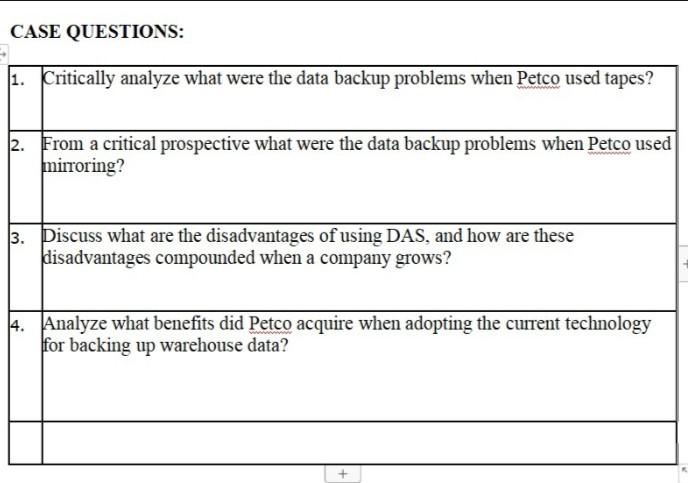Answered step by step
Verified Expert Solution
Question
1 Approved Answer
Better Storage for Our Best Friends At Petco animals always come first, says the Web site of Petco Animal Supplies, Inc. Established in 1965, the


Better Storage for Our Best Friends "At Petco animals always come first," says the Web site of Petco Animal Supplies, Inc. Established in 1965, the company is a leading retailer of pet supplies, from cat collars to aquariums to pet food. It operates more than 850 stores in 49 states and the District of Columbia, and sells more than 10,000 pet-related products. To accom modate customers, it also operates an online store. Because Petco maintains thousands of products in its warehouses, and because receiving and shipping takes place often, it must track in real time the location of each item. In its three main warehouses, workers use handheld devices equipped with both barcode and RFID capabilities. They are used to scan product bar- codes, record inventory receipts, and track shipping Instructions and execution. Because of the large num- ber of stores and the huge variety of items, Petco is highly sensitive to disruptions and downtime of its information systems. Downtime may cause significant financial damage due to lost sales. All this data must be recorded and backed up. Petco used magnetic tapes to back up data every few hours, but the approach was far from ideal. Tape backup is reliable, but the latency of a few hours posed a risk. If electric power was lost, so was several hours of data that could not be recorded. Also, recording on tape is labor-intensive, because tapes must be manually mounted and dismounted. Rewinding tapes is time- consuming, and therefore delays availability of new tapes for recording. Another issue with data storage was that the com- pany used the DAS (direct-attached storage) approach: each computer backed up to its own magnetic disk. The data could not be shared by all computers. This created two problems. Many of the disks were underutilized; much space-up to 50 percent-was never used. As the company grows, the total underuti- lized disk space grows as well. In addition, sharing the stored data was challenging. To overcome these problems, Petco IT staff tried mirroring. In disk mirroring, the entire disk is automati- cally copied to a backup disk. While this reduces labor The IT staff examined SAN (storage area network) and NAS (network-attached storage) solutions. It found that SAN would require much maintenance, while NAS required much equipment to handle data communica- tions. Petco opted for a system called iSCSI provided by Network Appliance, Inc., better known as NetApp. The system of backing up to DAS was replaced with backing up the Petco computers to NetApp servers over the Internet. iSCSI (pronounced "eye scuzzy") utilizes the existing Internet standards and network, and provides very fast data transfers. The adopter does not need to incur the typical expense of optical fiber networks asso ciated with SAN. The magnetic disks and the software that manages them were implemented in the three main warehouses. Compared to the DAS approach, using such a sys- tem reduces the total amount of required storage capacity, because much of the capacity of directly attached disks is never used. The new arrangement does not require as much storage planning as was required with DAS. The company can add storage capacity whenever data management needs require it. This eliminates wasted money spent on excess capacity. Thus, the storage system is scalable. It is easy and inexpensive to add more disks at any of the three warehouses. Another benefit of using this technology was that the system could be installed without interruption to warehouse operations. In fact, warehouse workers did not notice the change. They left work on Friday, and when they returned on Monday morning everything looked the same to them. Source: Pettis, A., "Petco's New Storage Gear is the Cat's Meow." eWeek, March 13, 2006: (www.petco.com), March 2007. CASE QUESTIONS: 1. Critically analyze what were the data backup problems when Petco used tapes? 2. From a critical prospective what were the data backup problems when Petco used mirroring? 3. Discuss what are the disadvantages of using DAS, and how are these disadvantages compounded when a company grows? 4. Analyze what benefits did Petco acquire when adopting the current technology for backing up warehouse data? Better Storage for Our Best Friends "At Petco animals always come first," says the Web site of Petco Animal Supplies, Inc. Established in 1965, the company is a leading retailer of pet supplies, from cat collars to aquariums to pet food. It operates more than 850 stores in 49 states and the District of Columbia, and sells more than 10,000 pet-related products. To accom modate customers, it also operates an online store. Because Petco maintains thousands of products in its warehouses, and because receiving and shipping takes place often, it must track in real time the location of each item. In its three main warehouses, workers use handheld devices equipped with both barcode and RFID capabilities. They are used to scan product bar- codes, record inventory receipts, and track shipping Instructions and execution. Because of the large num- ber of stores and the huge variety of items, Petco is highly sensitive to disruptions and downtime of its information systems. Downtime may cause significant financial damage due to lost sales. All this data must be recorded and backed up. Petco used magnetic tapes to back up data every few hours, but the approach was far from ideal. Tape backup is reliable, but the latency of a few hours posed a risk. If electric power was lost, so was several hours of data that could not be recorded. Also, recording on tape is labor-intensive, because tapes must be manually mounted and dismounted. Rewinding tapes is time- consuming, and therefore delays availability of new tapes for recording. Another issue with data storage was that the com- pany used the DAS (direct-attached storage) approach: each computer backed up to its own magnetic disk. The data could not be shared by all computers. This created two problems. Many of the disks were underutilized; much space-up to 50 percent-was never used. As the company grows, the total underuti- lized disk space grows as well. In addition, sharing the stored data was challenging. To overcome these problems, Petco IT staff tried mirroring. In disk mirroring, the entire disk is automati- cally copied to a backup disk. While this reduces labor The IT staff examined SAN (storage area network) and NAS (network-attached storage) solutions. It found that SAN would require much maintenance, while NAS required much equipment to handle data communica- tions. Petco opted for a system called iSCSI provided by Network Appliance, Inc., better known as NetApp. The system of backing up to DAS was replaced with backing up the Petco computers to NetApp servers over the Internet. iSCSI (pronounced "eye scuzzy") utilizes the existing Internet standards and network, and provides very fast data transfers. The adopter does not need to incur the typical expense of optical fiber networks asso ciated with SAN. The magnetic disks and the software that manages them were implemented in the three main warehouses. Compared to the DAS approach, using such a sys- tem reduces the total amount of required storage capacity, because much of the capacity of directly attached disks is never used. The new arrangement does not require as much storage planning as was required with DAS. The company can add storage capacity whenever data management needs require it. This eliminates wasted money spent on excess capacity. Thus, the storage system is scalable. It is easy and inexpensive to add more disks at any of the three warehouses. Another benefit of using this technology was that the system could be installed without interruption to warehouse operations. In fact, warehouse workers did not notice the change. They left work on Friday, and when they returned on Monday morning everything looked the same to them. Source: Pettis, A., "Petco's New Storage Gear is the Cat's Meow." eWeek, March 13, 2006: (www.petco.com), March 2007. CASE QUESTIONS: 1. Critically analyze what were the data backup problems when Petco used tapes? 2. From a critical prospective what were the data backup problems when Petco used mirroring? 3. Discuss what are the disadvantages of using DAS, and how are these disadvantages compounded when a company grows? 4. Analyze what benefits did Petco acquire when adopting the current technology for backing up warehouse data
Step by Step Solution
There are 3 Steps involved in it
Step: 1

Get Instant Access to Expert-Tailored Solutions
See step-by-step solutions with expert insights and AI powered tools for academic success
Step: 2

Step: 3

Ace Your Homework with AI
Get the answers you need in no time with our AI-driven, step-by-step assistance
Get Started


